An official website of the United States government
 United States Department of Labor
United States Department of Labor
Operate, install, adjust, and maintain integrated computer/communications systems, consoles, simulators, and other data acquisition, test, and measurement instruments and equipment, which are used to launch, track, position, and evaluate air and space vehicles. May record and interpret test data.
Employment estimate and mean wage estimates for Aerospace Engineering and Operations Technologists and Technicians:
| Employment (1) | Employment RSE (3) |
Mean hourly wage |
Mean annual wage (2) |
Wage RSE (3) |
|---|---|---|---|---|
| 10,640 | 4.0 % | $ 39.08 | $ 81,280 | 1.4 % |
Percentile wage estimates for Aerospace Engineering and Operations Technologists and Technicians:
| Percentile | 10% | 25% | 50% (Median) |
75% | 90% |
|---|---|---|---|---|---|
| Hourly Wage | $ 24.06 | $ 29.56 | $ 37.42 | $ 47.81 | $ 54.79 |
| Annual Wage (2) | $ 50,050 | $ 61,490 | $ 77,830 | $ 99,440 | $ 113,970 |
Industries with the highest published employment and wages for Aerospace Engineering and Operations Technologists and Technicians are provided. For a list of all industries with employment in Aerospace Engineering and Operations Technologists and Technicians, see the Create Customized Tables function.
Industries with the highest levels of employment in Aerospace Engineering and Operations Technologists and Technicians:
| Industry | Employment (1) | Percent of industry employment | Hourly mean wage | Annual mean wage (2) |
|---|---|---|---|---|
| Aerospace Product and Parts Manufacturing | 4,700 | 0.92 | $ 39.33 | $ 81,800 |
| Architectural, Engineering, and Related Services | 2,710 | 0.16 | $ 37.36 | $ 77,700 |
| Navigational, Measuring, Electromedical, and Control Instruments Manufacturing | 540 | 0.13 | $ 45.02 | $ 93,630 |
| Scientific Research and Development Services | 460 | 0.05 | $ 39.26 | $ 81,660 |
| Management, Scientific, and Technical Consulting Services | 380 | 0.02 | $ 26.40 | $ 54,920 |
Industries with the highest concentration of employment in Aerospace Engineering and Operations Technologists and Technicians:
| Industry | Employment (1) | Percent of industry employment | Hourly mean wage | Annual mean wage (2) |
|---|---|---|---|---|
| Aerospace Product and Parts Manufacturing | 4,700 | 0.92 | $ 39.33 | $ 81,800 |
| Architectural, Engineering, and Related Services | 2,710 | 0.16 | $ 37.36 | $ 77,700 |
| Technical and Trade Schools | 230 | 0.16 | $ 32.28 | $ 67,140 |
| Communications Equipment Manufacturing | 120 | 0.15 | $ 38.00 | $ 79,030 |
| Navigational, Measuring, Electromedical, and Control Instruments Manufacturing | 540 | 0.13 | $ 45.02 | $ 93,630 |
Top paying industries for Aerospace Engineering and Operations Technologists and Technicians:
| Industry | Employment (1) | Percent of industry employment | Hourly mean wage | Annual mean wage (2) |
|---|---|---|---|---|
| Management of Companies and Enterprises | 240 | 0.01 | $ 49.95 | $ 103,890 |
| Support Activities for Air Transportation | 140 | 0.06 | $ 49.94 | $ 103,870 |
| Navigational, Measuring, Electromedical, and Control Instruments Manufacturing | 540 | 0.13 | $ 45.02 | $ 93,630 |
| Other Professional, Scientific, and Technical Services | 100 | 0.01 | $ 41.32 | $ 85,950 |
| Computer Systems Design and Related Services | 370 | 0.01 | $ 40.85 | $ 84,960 |
States and areas with the highest published employment, location quotients, and wages for Aerospace Engineering and Operations Technologists and Technicians are provided. For a list of all areas with employment in Aerospace Engineering and Operations Technologists and Technicians, see the Create Customized Tables function.
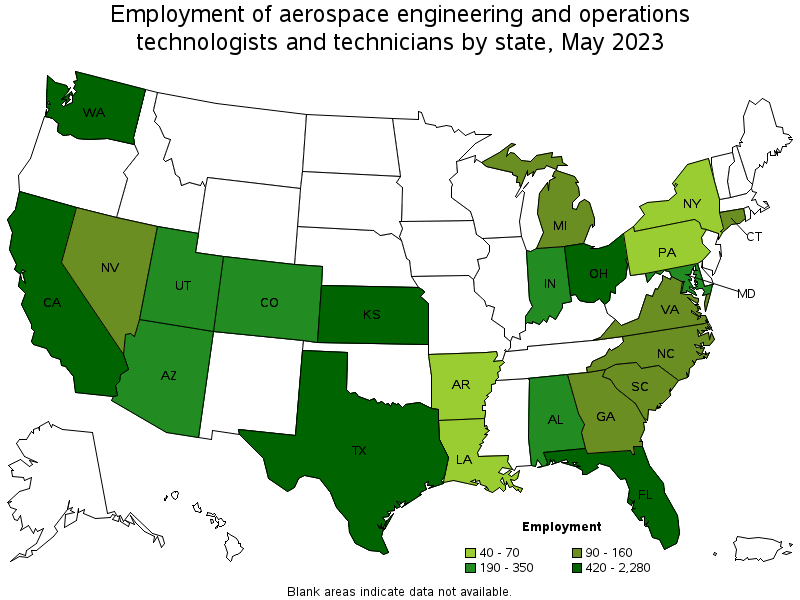
States with the highest employment level in Aerospace Engineering and Operations Technologists and Technicians:
| State | Employment (1) | Employment per thousand jobs | Location quotient (9) | Hourly mean wage | Annual mean wage (2) |
|---|---|---|---|---|---|
| Florida | 2,280 | 0.24 | 3.40 | $ 38.15 | $ 79,360 |
| California | 1,530 | 0.09 | 1.21 | $ 45.03 | $ 93,670 |
| Ohio | 1,070 | 0.20 | 2.79 | $ 37.45 | $ 77,900 |
| Kansas | 820 | 0.58 | 8.28 | $ 31.60 | $ 65,720 |
| Texas | 570 | 0.04 | 0.60 | $ 37.24 | $ 77,460 |
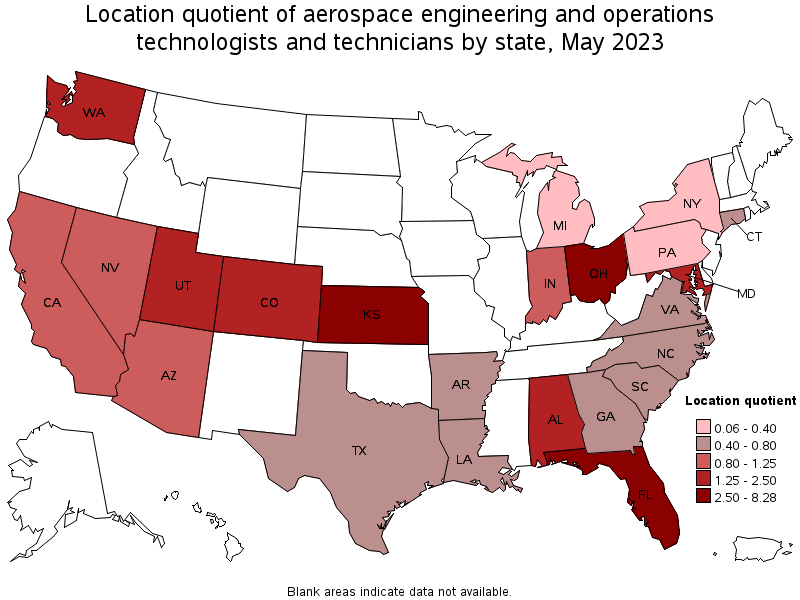
States with the highest concentration of jobs and location quotients in Aerospace Engineering and Operations Technologists and Technicians:
| State | Employment (1) | Employment per thousand jobs | Location quotient (9) | Hourly mean wage | Annual mean wage (2) |
|---|---|---|---|---|---|
| Kansas | 820 | 0.58 | 8.28 | $ 31.60 | $ 65,720 |
| Florida | 2,280 | 0.24 | 3.40 | $ 38.15 | $ 79,360 |
| Ohio | 1,070 | 0.20 | 2.79 | $ 37.45 | $ 77,900 |
| Utah | 270 | 0.16 | 2.31 | $ 36.17 | $ 75,230 |
| Alabama | 290 | 0.14 | 2.01 | $ 36.33 | $ 75,560 |
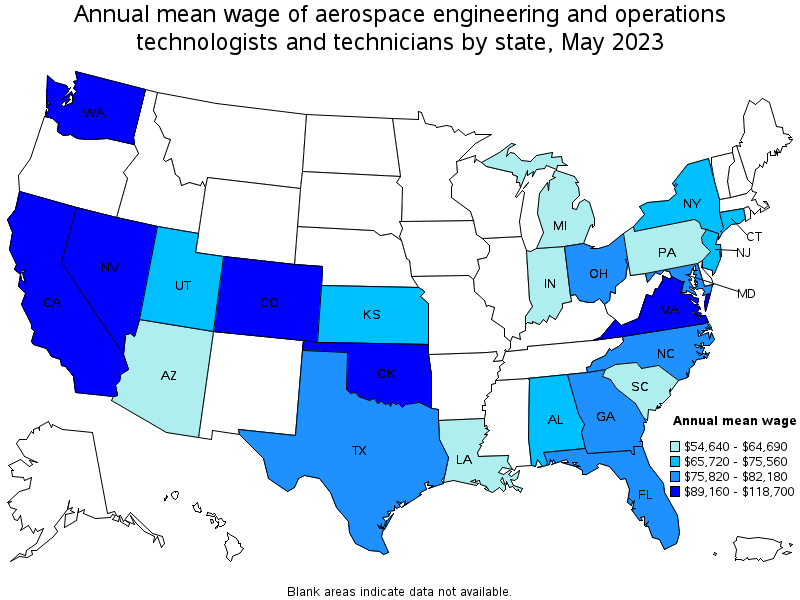
Top paying states for Aerospace Engineering and Operations Technologists and Technicians:
| State | Employment (1) | Employment per thousand jobs | Location quotient (9) | Hourly mean wage | Annual mean wage (2) |
|---|---|---|---|---|---|
| Colorado | 350 | 0.12 | 1.77 | $ 57.07 | $ 118,700 |
| Nevada | 90 | 0.06 | 0.91 | $ 49.20 | $ 102,330 |
| Washington | 420 | 0.12 | 1.72 | $ 46.71 | $ 97,170 |
| California | 1,530 | 0.09 | 1.21 | $ 45.03 | $ 93,670 |
| Virginia | 160 | 0.04 | 0.56 | $ 42.89 | $ 89,220 |
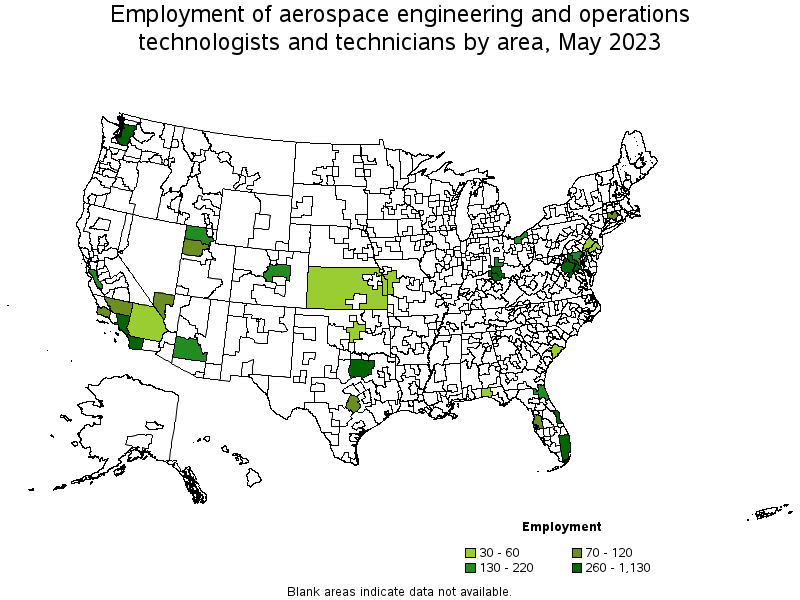
Metropolitan areas with the highest employment level in Aerospace Engineering and Operations Technologists and Technicians:
| Metropolitan area | Employment (1) | Employment per thousand jobs | Location quotient (9) | Hourly mean wage | Annual mean wage (2) |
|---|---|---|---|---|---|
| Palm Bay-Melbourne-Titusville, FL | 1,130 | 4.76 | 67.92 | $ 41.87 | $ 87,100 |
| Los Angeles-Long Beach-Anaheim, CA | 700 | 0.11 | 1.62 | $ 44.18 | $ 91,890 |
| Miami-Fort Lauderdale-West Palm Beach, FL | 530 | 0.19 | 2.77 | $ 35.68 | $ 74,220 |
| Seattle-Tacoma-Bellevue, WA | 390 | 0.19 | 2.70 | $ 47.35 | $ 98,480 |
| Cincinnati, OH-KY-IN | 360 | 0.34 | 4.79 | $ 36.48 | $ 75,890 |
| Washington-Arlington-Alexandria, DC-VA-MD-WV | 280 | 0.09 | 1.29 | $ 47.60 | $ 99,010 |
| San Diego-Carlsbad, CA | 270 | 0.17 | 2.49 | $ 38.62 | $ 80,340 |
| Dallas-Fort Worth-Arlington, TX | 260 | 0.07 | 0.94 | $ 34.57 | $ 71,910 |
| Dayton, OH | 220 | 0.61 | 8.67 | $ 35.46 | $ 73,750 |
| Denver-Aurora-Lakewood, CO | 210 | 0.13 | 1.87 | (8) | (8) |
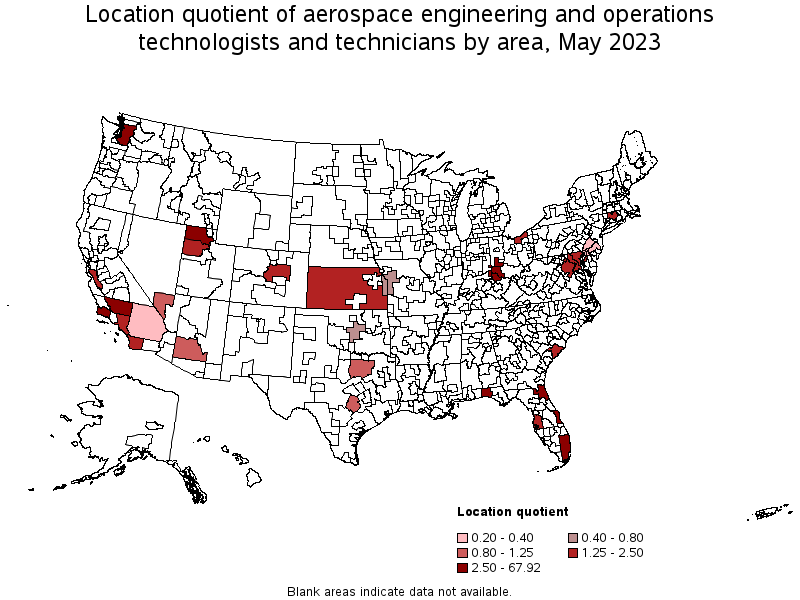
Metropolitan areas with the highest concentration of jobs and location quotients in Aerospace Engineering and Operations Technologists and Technicians:
| Metropolitan area | Employment (1) | Employment per thousand jobs | Location quotient (9) | Hourly mean wage | Annual mean wage (2) |
|---|---|---|---|---|---|
| Palm Bay-Melbourne-Titusville, FL | 1,130 | 4.76 | 67.92 | $ 41.87 | $ 87,100 |
| Dayton, OH | 220 | 0.61 | 8.67 | $ 35.46 | $ 73,750 |
| Ogden-Clearfield, UT | 140 | 0.50 | 7.08 | $ 36.30 | $ 75,510 |
| Santa Maria-Santa Barbara, CA | 80 | 0.38 | 5.38 | $ 50.79 | $ 105,630 |
| Cincinnati, OH-KY-IN | 360 | 0.34 | 4.79 | $ 36.48 | $ 75,890 |
| Crestview-Fort Walton Beach-Destin, FL | 40 | 0.32 | 4.62 | $ 42.59 | $ 88,590 |
| Bakersfield, CA | 90 | 0.28 | 4.02 | $ 37.49 | $ 77,970 |
| Miami-Fort Lauderdale-West Palm Beach, FL | 530 | 0.19 | 2.77 | $ 35.68 | $ 74,220 |
| Seattle-Tacoma-Bellevue, WA | 390 | 0.19 | 2.70 | $ 47.35 | $ 98,480 |
| Jacksonville, FL | 140 | 0.19 | 2.65 | $ 40.42 | $ 84,070 |
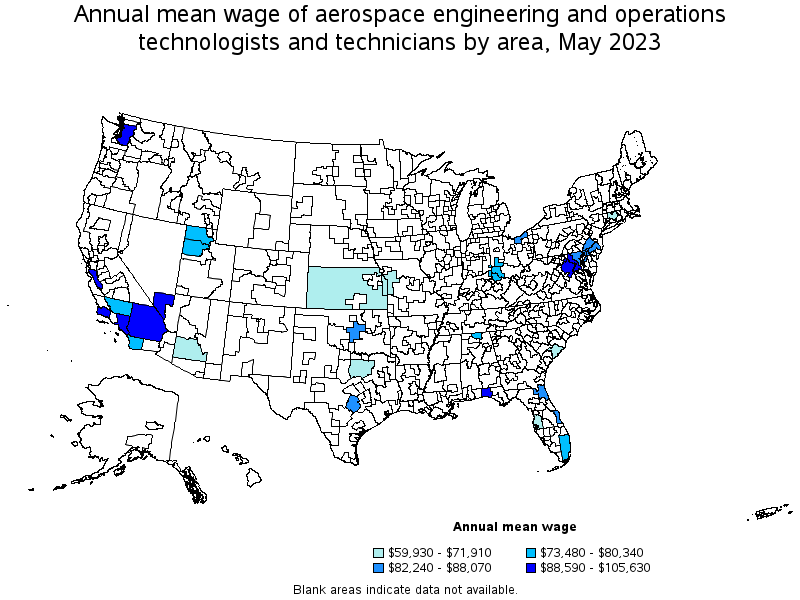
Top paying metropolitan areas for Aerospace Engineering and Operations Technologists and Technicians:
| Metropolitan area | Employment (1) | Employment per thousand jobs | Location quotient (9) | Hourly mean wage | Annual mean wage (2) |
|---|---|---|---|---|---|
| Santa Maria-Santa Barbara, CA | 80 | 0.38 | 5.38 | $ 50.79 | $ 105,630 |
| San Jose-Sunnyvale-Santa Clara, CA | 160 | 0.14 | 1.94 | $ 49.98 | $ 103,950 |
| Las Vegas-Henderson-Paradise, NV | 70 | 0.06 | 0.87 | $ 49.51 | $ 102,990 |
| Washington-Arlington-Alexandria, DC-VA-MD-WV | 280 | 0.09 | 1.29 | $ 47.60 | $ 99,010 |
| Seattle-Tacoma-Bellevue, WA | 390 | 0.19 | 2.70 | $ 47.35 | $ 98,480 |
| Riverside-San Bernardino-Ontario, CA | 40 | 0.03 | 0.37 | $ 45.86 | $ 95,390 |
| Los Angeles-Long Beach-Anaheim, CA | 700 | 0.11 | 1.62 | $ 44.18 | $ 91,890 |
| Crestview-Fort Walton Beach-Destin, FL | 40 | 0.32 | 4.62 | $ 42.59 | $ 88,590 |
| Austin-Round Rock, TX | 90 | 0.07 | 1.06 | $ 42.34 | $ 88,070 |
| Palm Bay-Melbourne-Titusville, FL | 1,130 | 4.76 | 67.92 | $ 41.87 | $ 87,100 |
Nonmetropolitan areas with the highest employment in Aerospace Engineering and Operations Technologists and Technicians:
| Nonmetropolitan area | Employment (1) | Employment per thousand jobs | Location quotient (9) | Hourly mean wage | Annual mean wage (2) |
|---|---|---|---|---|---|
| Kansas nonmetropolitan area | 60 | 0.14 | 2.03 | $ 30.62 | $ 63,690 |
Nonmetropolitan areas with the highest concentration of jobs and location quotients in Aerospace Engineering and Operations Technologists and Technicians:
| Nonmetropolitan area | Employment (1) | Employment per thousand jobs | Location quotient (9) | Hourly mean wage | Annual mean wage (2) |
|---|---|---|---|---|---|
| Kansas nonmetropolitan area | 60 | 0.14 | 2.03 | $ 30.62 | $ 63,690 |
Top paying nonmetropolitan areas for Aerospace Engineering and Operations Technologists and Technicians:
| Nonmetropolitan area | Employment (1) | Employment per thousand jobs | Location quotient (9) | Hourly mean wage | Annual mean wage (2) |
|---|---|---|---|---|---|
| Kansas nonmetropolitan area | 60 | 0.14 | 2.03 | $ 30.62 | $ 63,690 |
These estimates are calculated with data collected from employers in all industry sectors, all metropolitan and nonmetropolitan areas, and all states and the District of Columbia. The top employment and wage figures are provided above. The complete list is available in the downloadable XLS files.
The percentile wage estimate is the value of a wage below which a certain percent of workers fall. The median wage is the 50th percentile wage estimate—50 percent of workers earn less than the median and 50 percent of workers earn more than the median. More about percentile wages.
(1) Estimates for detailed occupations do not sum to the totals because the totals include occupations not shown separately. Estimates do not include self-employed workers.
(2) Annual wages have been calculated by multiplying the hourly mean wage by a "year-round, full-time" hours figure of 2,080 hours; for those occupations where there is not an hourly wage published, the annual wage has been directly calculated from the reported survey data.
(3) The relative standard error (RSE) is a measure of the reliability of a survey statistic. The smaller the relative standard error, the more precise the estimate.
(8) Estimate not released.
(9) The location quotient is the ratio of the area concentration of occupational employment to the national average concentration. A location quotient greater than one indicates the occupation has a higher share of employment than average, and a location quotient less than one indicates the occupation is less prevalent in the area than average.
Other OEWS estimates and related information:
May 2023 National Occupational Employment and Wage Estimates
May 2023 State Occupational Employment and Wage Estimates
May 2023 Metropolitan and Nonmetropolitan Area Occupational Employment and Wage Estimates
May 2023 National Industry-Specific Occupational Employment and Wage Estimates
Last Modified Date: April 3, 2024